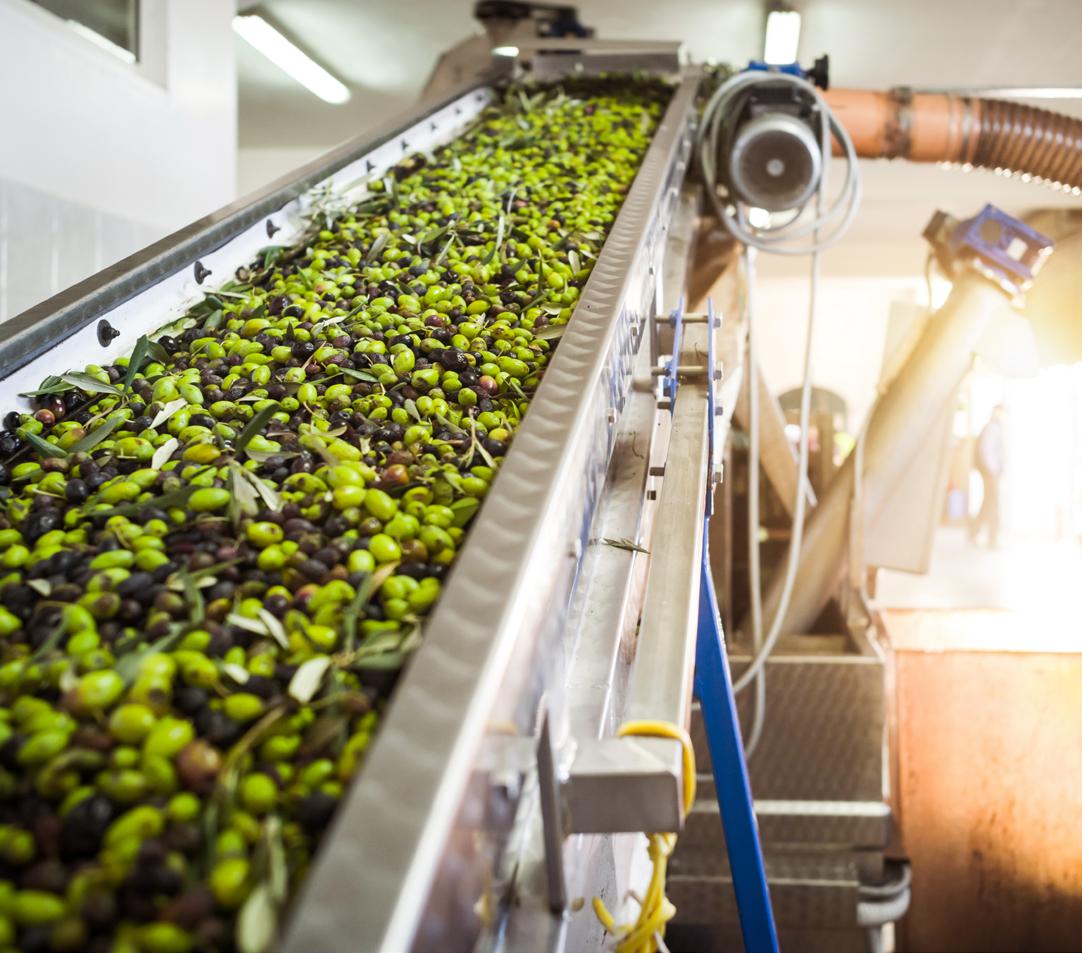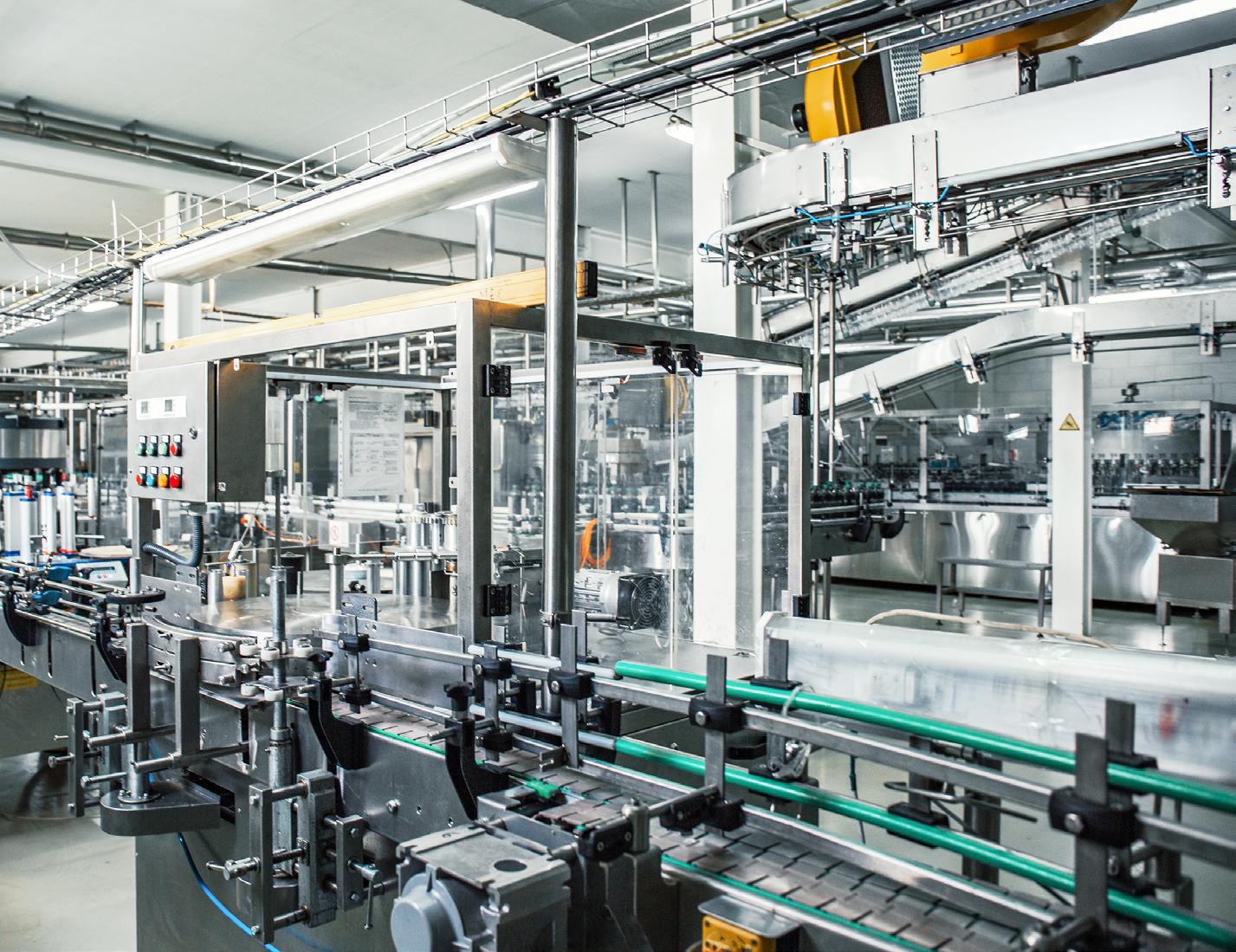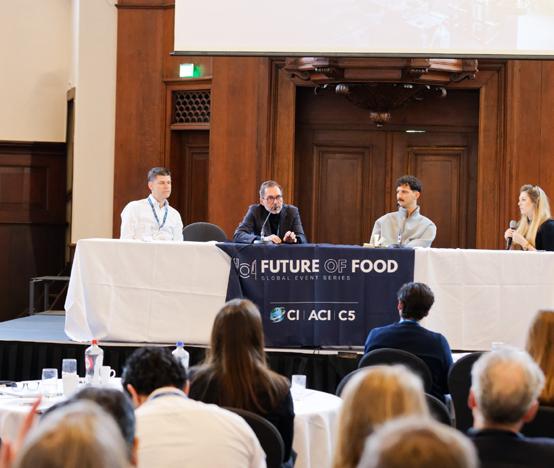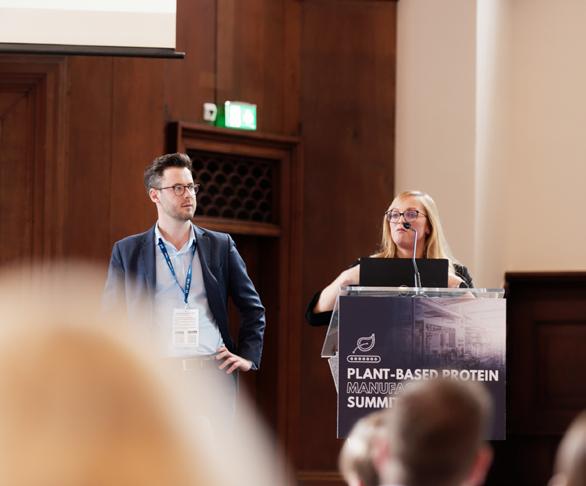



























By 2027, the global plant-based industry is projected to reach a significant US$15.7 billion, up from US$7.9 billion in 2022. Throughout this forecast period, the plant-based food and drink industry is expected to rise at a staggering compound annual growth rate (CAGR) of 14.7%.1
Though such growth is worth celebration, there is a chink in the expanding plant-based industry’s new and shiny armour – capacity. In recent years, consumer demand for alternative-protein products has often outpaced the industry’s supply chain capabilities. Failure to meet industry production targets may, ultimately, manifest in higher product prices and limited availability to consumers, damaging the industry’s growth and reducing the uptake of plant-forward diets.

Around the world, manufacturers are running into difficulties expanding production capacity to meet the needs of restaurants and retail outlets’ eager to offer novel and sustainable products. So, what’s the answer? We must create a new and highly efficient supply chain.
To meet rising consumer demands for plant-based food and drink, it is estimated that the industry will need to operate at least 800 manufacturing facilities – each producing on average 30,000 metric tonnes of product annually – within the decade. Achieving this would involve an investment of at least US$27 billion, underscoring the importance and urgency of bold infrastructure investments and innovation. The private sector – investors, ingredient processors, extrusion equipment providers, and manufacturers alike – can realize significant financial upside by building out this new supply chain.


While some companies will build out their own manufacturing capacity, this won’t be achievable for all – it can be expensive, time-consuming, and challenging to develop processes and capabilities in-house. The cheaper alternative is contract manufacturing and outsourcing. Yet, co-manufacturing is not without its own difficulties.



Meanwhile, money that is spent on infrastructure has high opportunity costs (particularly for start-ups), considering the amount of R&D, sales, and marketing investment needed to get novel products and services to market.
Meeting the demand for plant-based products with supply will be easier said than done. But with the right forethought, investment, and industry innovators, we can engineer a smooth and faultless approach to alternative protein production. One, that reaches a scale that’s on-par with the conventional meat industry, meets consumer demand, and supports a future of sustainable food production.
This report will explore how the alternative-protein industry is responding to the urgent need for increased production capacity. It will also look at how new production technologies are currently being incorporated into plant-based manufacturing, sharing case studies across the supply chain.
Our objective is to provide key insights and advice to support companies to effectively scale upstream and downstream processing, implement innovative technologies and create a flexible and efficient supply chain for plant-based products.

It is of vital importance that we establish a refined system for the production of plant-based food and drink products – and soon. But before we delve into how to achieve this, let’s backtrack a bit and look at the why to gain a better understanding of the industry, including its drivers and dynamics.


Finding new ways of producing food is a necessity, given that the global population is predicted to reach nine billion by 2050. This incredible rise will require almost double the current output from the food production system, meaning that our planet’s dwindling land, water, and other resources will be in even higher demand.
But if we switch to producing more alternative-proteins, we can feed this growing population. This is because plant-based foods require significantly less resources for production. To put this into numbers, one pound of beef requires between 2,000 and 8,000 gallons of water to produce, whereas the same amount of tofu requires just 302 gallons.2 Likewise, it takes around 100 times as much land to produce a kilocalorie of beef or lamb, compared to plant-based alternatives.3
By producing more plant-based foods, we have a more sustainable means of feeding our snowballing world population.
Consumer demand for alternative proteins is increasing, but why? What is pushing consumers to buy more plant-based food and drink products?

Motivations for consuming plant-based food products vary widely, with four of the main consumer drivers including: increasing health consciousness, environmental concerns, a greater desire to try novel, tasty food products, and animal welfare concerns. Consumers are searching for food products that satisfy these motivations, with health and taste being the two most important influencing purchasing factors at present.
Alongside this, the number of consumers following plant-forward diets is increasing. This includes plant-based/vegan, vegetarian, pescatarian, and flexitarian approaches to eating, with flexitarians leading the way. Remarkably, a recent survey found that flexitarians and reducetarians represent almost half (40%) of consumers in many countries, and account for the vast majority of plant-based purchases.4 Indeed, almost half of Americans regularly purchase both dairy and plant-based milk during their weekly shop,5 plus one study analyzing household purchasing data found that 86% of households that purchased meat alternatives also purchased conventional meat. This suggests that the ‘flexitarian’ segment of consumers is driving the plant-based industry in the US.
These shifts in consumer demand are pushing businesses to produce innovative, healthy, delicious, sustainable, and convenient alternative protein products, further stimulating consumer demand.
2 Hunnes, Dana PhD, MPH, RD, The case for plant-based. UCLA. Available at: https://www.sustain.ucla.edu/food-systems/the-case-for-plant-based/. Accessed 2023-04-05.
In recent years, a whole host of new alternative-proteins have been developed, the likes of which have the potential to compete with traditional meat products and attract even more consumers to the animal-free food market. These alternative-proteins possess all the sensory properties of animal meat – taste, look, texture, and smell – but do not involve animals in their production.

As we know, consumer demand for products like these is there – and rising – but most product developers face the question of scalability. How can these new developments be scaled up (in a way that’s cost-effective) to meet demand? There’s no point in creating novel proteins for consumers if there is no way to mass-produce them for the market. Yet, if scalability occurs, these developments are set to explode in uptake and the market is primed for success.
You need to partner with food manufacturers and/or factory planners and equipment suppliers and be prepared to build your own production facility to enable you to take new food development to market.

3 If the world adopted a plant-based diet we would reduce global agricultural land use from 4 to 1 billion hectares, (2021). Our World in Data. Available at: https://ourworldindata.org/land-use-diets. Accessed 2023-04-05.
4 How to target flexitarians with plant-based products, (2022). ProVeg International. Available at: https://corporate.proveg.com/article/how-to-target-flexitarian-consumers-with-plant-based-products. Accessed 2023-04-05.
5 Watson, E (2019): 48% of consumers buy plant-based and dairy milks, reveals IPSOS survey. Food Navigator. Available at: https://www.foodnavigator-usa.com/Article/2019/01/24/48-of-consumers-buy-dairy-and-plant-based-milks-reveals-IPSOS-survey#. Accessed 2023-04-05.

It is of vital importance that we establish a refined system for the production of plant-based food and drink products – and soon. But before we delve into how to achieve this, let’s backtrack a bit and look at the why to gain a better understanding of the industry, including its drivers and dynamics.
To keep up with the rapid spike in consumer demand, plant-based food manufacturers are growing as quickly as possible. For now, they’re relying on established technologies to support this growth, including extrusion for generating the ‘muscle fibre’, and meat and dairy processing equipment to develop the final product. But these existing methods were not created for alternative-protein products, which vary greatly in ingredients and final product.
Luckily, innovative processing methods and equipment are on the verge of displacing these traditional methods. Researchers and companies are developing novel and proprietary extrusion alternatives, including shear cell technology, 3D printing, spinning technology, and other novel manufacturing approaches. Other companies are ditching extrusion or sophisticated structuring approaches altogether, instead using simple ingredient blending and mixing approaches to create products in facilities that closely resemble traditional meat processing plants. There are now efforts by researchers, manufacturers, and entrepreneurs to expand the reach of plant-based meat production methods to further optimize for texture and taste.
To stay relevant and competitive far into the future, you need a plan for integrating these new technologies into the core of your manufacturing process, quickly and flexibly.

In the last 10 years, the alternative-proteins sector has attracted a staggering $14.2 billion in private capital, with annual investments nearly doubling every year on average (though with high variance, which is standard for a young industry).6 In 2022 alone, plant-based meat, seafood, eggs, and dairy companies raised US$1.2 billion (representing 15% of all-time investment since 1997), with the year’s largest investment amounting to US$135.6 million, raised by plantbased brand Redefine Meat.7
Both investment value and the number of investors are growing each year, with the number of unique investors in plant-based companies rising by 17% in 2022 to more than 1,500 investors.8 These figures demonstrate the significant potential of the industry.

Whether you build new plants or develop collaborations, expanding production capacity should be your top priority and will be vital to your commercial success. Those who can future-proof their operations with flexible, innovation-friendly designs and processes will find scaling up much easier, faster, and more cost-effective, which could mean the difference between a share in the rapidly growing alternative protein market – or a quick fall-out.
For example, in 2022, six companies opened new or expanded production facilities, while 11 new plant-based contract manufacturers were added to the Good Food Institute's Database, bringing the total number of known plant-based contract manufacturers to 127.9

An annual capital spending survey forecasts a 16.6% boost in new design-build projects, as food and beverage (F&B) producers pump up the size of their buildings to accommodate for more lines and additional SKUs. Stay ahead of the game and focus on your production capacity – essentially, it’s keep up or get left behind.
7 ,
8 The state of the industry: highlights, (2020). The Good Food Institute. Available at: https://gfi.org/blog/2020-state-of-the-industry-highlights/. Accessed 2023-04-05.


9 The plant-based state of the industry report, (2022). The Good Food Institute. Available at: https://gfi.org/wp-content/uploads/2023/01/2022-Plant-Based-State-of-the-Industry-Report.pdf. Accessed 2023-04-02.

Plant-based companies with their own production plant:
M Impossible Foods
M Beyond Meat
M Demolish Foods
M Redefine Meat
M NOVAMEAT
M Oatly
M Meati Foods
M Gathered Foods
M Black Sheep Foods
M Farm Foods/Down To Earth
M Follow Your Heart
M Before the Butcher
M Abbot’s Butcher
M Eat Just
M Miyoko’s Creamery
M La Loma Foods
M Purefield Ingredients
M Califia Farms
Co-manufactures who can accommodate plant-based:
M Schreiber Foods
M Real Vision Foods
M Century Foods
M Brecks Foods
M Schouten
M Gathered Foods
M Farm Foods USA
M Framptons
M Esti Foods
M Hearthside Foods
M ETA Plant based manufacturing
Equipment Suppliers:
M Coperion
M Clextral

M Albert Handtmann
M PerMix Tec. Co.
M MatCon
M Multivac
M GEA
M Buhler M Vemag M Brabender M JBT M Formac
M Wenger manufacturing
Design, Engineering and Construction firms:
M Stellar
M Hixson Architecture & Engineering

M CRB
M Gray Solutions
M Food Plant Engineering
M Haskell Company

M Shambaugh & Sons
M RSK Group
M ARCO/Murray
M Edison Group
M BLACK & VEATCH
Manufacturing is often disregarded when it comes to investment – to the detriment of the entire plant-based food and drink industry. Research shows that most investors that focus on alternative-proteins do so more generally, with an interest in individual start-ups' with less attention given to the ‘bigger picture’ of the industry. As a result, there is a lack of investment across different B2B solutions. This is the unglamourous picks and shovels business but so critical and neglected at the moment.
Greater investment (and more investors) is needed in companies that lead manufacturing and supply chain aspects of the alternative-protein industry, with a focus on building-up manufacturing processes and equipment. This will provide more co-manufacturing partnerships for those start-ups that cannot afford to build/expand their own facilities, plus, easier access to more specialist equipment for those businesses that require it.
This topic is now a key challenge for the industry, but what’s the answer?
• Prioritize partnerships – investment solutions can be accelerated through collaboration. To succeed, the interests of multiple different entities must be aligned – investors, financing providers, startups, equipment suppliers, and ingredient input suppliers, making this a tough problem to solve. Events like the Plant Based Protein Manufacturing Summit where multiple sectors and entities come together in one place can provide networking scenarios where conversations leading to this collaboration can begin.
• Choose the right investment partners – seek out partners who understand your vision and are appropriate for your stage of growth.
• Ensure there is a path to profitability – as well as true B2C or B2B) product demand.
• Choose the right kind of investment for your business – some of the most popular investment options include:
» Personal investment
» Investing your business’s current profits
» Bank Loans and Lines of Credit
» SBA Loans – 7(a) Loan Programme, 504 Loan Programme, 7(m) Micro Loan Programme

We have some fantastic investors that are not afraid of capital investment, which means when we get to the point that we've got a product that we need to produce, and we don't have the equipment for it, they will go out and buy it and stand by us. Of course, we've got to show them that we're going to move. But that's all part of he game to continue to grow. So on the production or manufacturing side, I feel really comfortable about where we are today and our ability to expand and grow and meet the demand.
Danny O’Malley, Founder and President Before the Butcher» Investors – Institutional or Angel
» Crowdfunding
» Initial Public Offerings (IPOs)
» Direct Public Offerings (DPOs)
» Small Corporate Offering Registrations (SCORs)

» Venture Capital (VC)
» Small Business Innovation Research (SBIR) grants
• What financing source you end up with will be dictated by several considerations – including how much money you need, how long you need it, what you will need it for, and how much control over your business you’re willing to relinquish. For example, if it’s a few million dollars that you need to raise, then VC, a stock offering, or an Angel Investor might be your best bet. Yet if the amount you need is much less than that, going via Crowdfunding or an SBA Loan would be better.

Supply Change Capital invests in the future of food. With a lens for culture and climate, investments focus on early stage technology companies that are responding to the seismic shift that is occurring in the US$6 trillion food industry. This includes innovation happening across the ingredient technology spectrum.
Successes and solutions: Helping to build-up infrastructure for the alt-protein industry by investing in technologies that touch the alternative-protein industry.
Supply Change Capital (SSC) was an early investor in Aqua Cultured Foods, a Chicagobased business that is creating a platform for alternative proteins based on scalable and economically competitive fermentation technology, starting with seafood.





SSC also invested in Chicago-based Hyfé Foods. Hyfé is repurposing wastewater from the food industry into competitive and climate positive feedstocks for fermentation, including for the production of alternative proteins.
The business is also a lead investor in Michroma, a company utilizing fermentation to create the next generation of petroleum-free colorings and flavorings for the food industry, including applications for the alt-protein sector.

1.Is currently enough investment in developing infrastructure and building-up capacity for the alt-protein industry?
More investment needs to flow to the development of infrastructure where there are viable businesses developing products that consumers want.
There also is a need for industry-level innovation and for policy support to enable both innovation and the scale up of wrap-around services for the alternative protein industry. For instance, government funding for early stage research and R&D is critical, as well as an enabling policy environment where regulatory agencies are coordinating to create a go-to market path. We also need clear consumer communications and messaging around these new products.
In this environment it is difficult to secure financing for CapEx, particularly for early stage companies that do not have a lot of revenue.
Make sure you seek out partners who understand your vision and are appropriate for your stage of growth.
And above all, ensure there is a path to profitability, as well as true consumer (B2C) or customer (B2B) demand for your product.

Finding, hiring and training labour is a tough market in most industries, but especially when it comes to specialist positions in alternative-protein businesses or occupations whereby new food tech is being developed. Plant-based manufacturers often use novel processing methods. This makes it especially challenging to find qualified personnel, or, if they’re trained in-house, especially painful to replace them.
So, how do we go about finding the right staff, and filling this knowledge, and talent gap?
• Outsource your talent search – hiring agencies can assist F&B manufacturing companies in recruiting specialized roles due to their unique sourcing and expansive networks. Resultantly, they can source candidates that possess niche skills and experiences.
• Train personnel in-house – hill the talent and knowledge gap in-house and provide your company with its own specialist staff. Additionally, provide more training to all staff to upskill less experienced workers. Conversely, it can be painful and expensive to replace and retrain these staff.
• Offer student pathways, apprenticeships, and mentorship programmes –university students with relevant degrees make ideal candidates for specialist training and employment programmes. Likewise, mentorship programmes and apprenticeships can be invaluable (and very low cost) ways to transfer knowledge from your seasoned pros to your newbies.
It starts by having a team built around skills and expertise across culinary, food science, product development, process engineering, quality and food safety disciplines working together in a collaborative environment for creating innovative new product and technology platforms.
 Paul Neumann, SVP of R&D and Innovation Daring
Paul Neumann, SVP of R&D and Innovation Daring
• Recruit from similar industries – utilize talent from industries akin to your own, for example, recruiting someone who worked within the R&D department of a beef company to work in the R&D department of an alt-beef company. Use your connections in F&B to source this talent.
• Leverage LinkedIn – the platform is a great tool for sourcing talent across the pool from around the world; make connections with as many skilled individuals in your industry as you can.
• Network, network, network – attend industry events in the F&B, plant-based, and manufacturing spaces to make connections and source relevant, skilled talent.


In most industries, business partnerships are vital for things to run smoothly and profitability. In a young industry, like plant-based product manufacturing, effective partnerships are even more important as companies battle to establish supply chains, create technology, build equipment, source talent, and take new products to market. To meet burgeoning demands for increased capacity, businesses will need to build effective partnerships with one another, but how? And how can these be maintained, short- and long-term?
When choosing a strategic partner, keep the following in mind:
• Both parties in a prospective collaboration need to be sure that they will deliver a sufficient. return to justify the upfront investment.
• Both partners must have sufficient common strategic interests to support the collaboration.
• Select partners based on capability, strategic goals, and value potential.
• Remember that the the biggest potential partner might not be the best one.
• Ensure the partner has the right infrastructure to provide a basis for the collaboration.
• Learn how a prospective partner handles its current facilities.
• Ideally, find a partner that’s already making/packing plant-based products and understands the complexities. If you can’t find that type of facility then source an establishment that handles similar products to yours.
• Most importantly, find a partner that you can trust.


• Establish a clear foundation from the offset – It seems obvious that partner companies would aim to find common ground at the beginning, especially in joint ventures where both parties have big financial stakes, or in examples in which extreme differences in cultures, communications, or expectations exist. However, in the rush to complete a deal, talks about mutual goals can often get waylaid. This is particularly true in similar industries where all partners assume that they are already on the same page. By not establishing a clear foundation from the offset, companies place increased stress on a partnership and reduce chances of success. Combat this by ensuring that the individuals expected to lead day-today operations of the partnership are part of initial negotiations. Transparency from the offset is the only way to ensure everyone understands partners’ goals and that everyone is using same measures of success.
• Communicate consistently to curate trust – Even business partnerships that started off great can crumble, due to individual biases and common communication and collaboration issues. Take measures to prevent this – communicate consistently with your strategic partners, connect socially, keep all parties in the loop, and recognise each others teams’ capabilities, cultures and motivations. It also helps to structure your communications in a standardised way that can be understood by all parties, to avoid miscommunications.
• Be present, and emphasise accountability – Like any successful relationship, the management of a business partnership cannot be one sided. Good governance is the lichen for successful collaboration. Critical senior executives in partnership organisations should remain involved in the overview of a partnership, or at minumum, each partner should assign a senior line executive from the company to be ‘deal sponsor’ – someone to keep operations’ leaders and alliance managers focused on priorities, advocate for required resources, and generally create a cooperative environment for everyone.10
Creating trust between brands and suppliers of plant based protein with co-mans and equipment suppliers is critical. And that’s not always easy because oftentimes the place where the co-mans and the equipment suppliers are located and where the plant-based company is may be different – they may not have met before. So, building trust is critical.
Sandeep Sibal, CEO Demolish Foods• Build a dynamic partnership – The scope of partnerships are likely to shift overtime, so it’s important that partner organisations accept this inevitability and plan for it at the outset. Partners should consider the possibility of restructuring during the negotiation process –ideally framing the potential endgame for the relationship. Ask questions like, what market shifts might occur, how might that affect both sides’ interests and incentives, and what mechanisms would allow for orderly restructuring? Such dialogues about the partnership’s future, while potentially stressful, should be conducted regularly.11
• Establish a joint-performance management system – Ultimately, you want to be able to check that your long-term project is on-track and delivering the results it should. In F&B collaboration efforts, both parties should use the same performance-management system. By building common metrics and targets – and jointly monitoring progress – companies avoid misaligning incentives.

The plant-based food and beverage industry is still young, but as we know, it’s growing rapidly. If you’re looking to expand your business to meet this blossoming demand you’ll need to scale up your supply chain and know how to overcome any constraints, issues, or gaps – which is easier said than done.
If you’re a new start-up, you’re likely full of questions: how can you expand production without losing flexibility? How do you go from a small-scale, manual production facility to a more industrialized and more automatic production facility? How do you create the same process or experience at scale as in a commercial kitchen? And, how can you grow your production and add new products without compromising on your baseline product?
• Take notes that chart your experiences from line expansion to scale – what can you learn from your first line? Implement these lessons into your next.
• Use existing supply chains to help scale – e.g. share trucks with other plant-based brands or those from the conventional meat industry who are going to the same retailers as your products.
• After the pilot stage, bridge with a co-manufacturer – then, jump into scaling on your own.
• Backup everything you do – have at least two suppliers for every ingredient, in case of supply emergencies.
• Remain vigilant – just because your supply chain looks positive today, doesn’t mean it will be tomorrow. Constantly look ahead and watch markets, world news and economies, and track possible supply chain hazards.


We have some fantastic investors that are not afraid of capital investment, which means when we get to the point that we've got a product that we need to produce, and we don't have the equipment for it, they will go out and buy it and stand by us. Of course, we've got to show them that we're going to move. But that's all part of he game to continue to grow. So on the production or manufacturing side, I feel really comfortable about where we are today and our ability to expand and grow and meet the demand.
Danny O’Malley, Founder and President Before the Butcher
Before the Butcher creates a diverse mix of plant-based burger patties, grounds, chunks, shreds, and more, with an aim to replace traditional meats in favourite recipes. The company strives for innovation in all they do, becoming a plant-based category leader in flavour, variety, and texture. Before the Meat products are available for consumers through retail and foodservice channels
Successes and solutions: An efficient supply chain that is emergency-proofed and backed up on multiple fronts to ensure production is never affected.


1.When and how did you first tackle scaling up and overcoming any supply chain constraints? What does the supply chain landscape for Before the Butcher look like today?
The cool thing about when we started, was that the ball had really started to roll a little bit with Beyond Meat and Impossible, and some other larger companies that had already been doing vegan and vegetarian plant-based meat products. So, the wheels were already turning! We were pretty fortunate to jump on the coattails of the supply chains that were out there already. But it was still much more limited than it is today.
So today, now that we’ve gotten through a really rough stage, which was COVID and thereafter, where we had tremendous supply chain problems. The ingredient suppliers out there have either caught up or are catching up; many of them are now oversupplied because the industry has settled a little bit. So we’ve noticed some changes in that area, which are positive for us today. But that doesn’t mean they’ll be positive tomorrow.
I think the exciting thing about the supply chain and coming right from the ingredient base from the fields, is because of the excitement around this industry in the past six, seven years, there’s a lot of entities that have jumped in and started producing the type of products that we need in order to make the products that the consumer wants.
So the supply chain today is actually pretty good. Now, if you asked me that a year and a half ago, I would have broken it down and cried with how difficult it was.

Starting with the supply chain, we now know from experience, to backup everything that we do. So we always look to have two to three suppliers for every ingredient that we have. Sometimes it’s difficult to do that, sometimes it’s almost impossible because we work with ingredient suppliers for very specific products that we need. And then when you have a proprietary product that’s been made for you, you can’t really get a backup to it.
Ideally, we stick with one supplier because the more you buy from that supplier, generally speaking, you get the best price right? And then they consistently produce the product for you and for others, if others are using that product. And then they have their basis, so that’s good for all on the supply chain.
On the production side, we’ve consolidated our facilities; we used to have two facilities, one in Orange County, California, and one in San Diego, California. Last year, we built out 35,000 square feet, dedicated to plant-based with our partner, and we’re working toward expanding that as well with another 10,000 square feet. And our investors just bought a 45,000-square-foot building that’s dedicated to plant-based in the next two to three years. Right now we’re using it for dry storage because we used up all the space that we could expand in our current facility. So we’re really excited about that.

Choosing whether to work with a co-manufacturer is a big decision to make. Then, you need to decide which parts to keep manufacturing in-house and which parts to allocate to your co-man!

Luckily, it’s a decision that many brands are making all the time, and so there are great numbers of companies you can go to for advice – utilise your network.


• There is no one-size fits-all answer – make your decision based on your business’s goals, the uniqueness and specificity of your product, and your ability to find a trust-worthy co-man that is within budget, standards, and volume needs. You must also be able to meet their minimum order quantity. Talk to professionals in your network about their experiences working with co-mans and/or with manufacturing in-house.
• Benefits to using a co-man – you don’t have to learn to manufacture at-scale or raise money to build-out a manufacturing capacity/build your own facility. You can take advantage of skills that you do not possess, and you can cut out your overhead expenses to bring up profit margins and focus your business’s resources on developing your brand and product marketing. Plus, there is increased management of costs and you have access to ingredients at reduced costs –since co-mans often benefit from ‘economies of scale’. Building out your own manufacturing capacity can be time-consuming, expensive, and challenging.
• Cons to using a co-man – You must relinquish part of your margin, and you will no longer oversee the production of each item.

Ideally, you’re going to find a partner that you trust and that works for your benefit as well as their own. And you could find a happy medium, because it’s never going to be perfect – they’re going to make mistakes, you’re going to make mistakes. At some point in time you won’t be happy with what they do, and they won’t be happy what you do!
Danny O’Malley, Founder and President Before the Butcher
Intellectual property (IP) is a hot topic in the world of F&B manufacturing and innovative technologies. If you have developed something incredible – a plantbased alternative that will really shake up the industry – it makes good sense to protect others from stealing the idea. That’s where IP, trademarks, and patents come in.
“In any fast-growing and innovative industry, it is important to protect intellectual property at an early stage,” says Georgia Mann, Associate European and UK Patent Attourney at Withers & Rogers. “Doing so ensures a stake in the market. Conversely, failing to secure IP protection can leave the way open for competitors to steal market share and potentially reverse engineer innovations.”
“We are also seeing an increase in patent disputes and litigation in the alternative protein sector. This suggests that IP protection for alternative proteins will become increasingly important. Owning IP rights not only enables innovators to legally secure market share, but IP protection can also be used to secure investment, provide negotiating leverage, act as collateral, and can even be used to obtain tax reductions. It can therefore be an incredibly useful business tool for businesses.”
Alongside IP, Process Ownership considerations are necessary for any new business or tech developers – what are the pros and cons of own and developing a process versus outsourcing? Reflect on this early on in company and product expansion.
For many start-ups, strategic business partnerships (i.e. working with co-mans) and outsourcing are vital to expansion. If this is the case for your business, it’s important that you think carefully about your IP before getting involved in any collaboration or giving away trade secrets. Georgia adds: “Collaboration has become increasingly more widespread in all areas of research science but is particularly prevalent in the food industry. Collaboration has numerous advantages, such as acceleration of the innovation process and helping bring solutions to market more quickly. However, collaborating with other companies or outsourcing aspects of production requires care, as it would usually involve sharing a certain amount of intellectual property upfront.”
• File for an IP and/or patent application before launching – avoid launching your brand after you’ve invested time, money, and passion, just to be told that someone else has beaten you to it.
• Hold difficult conversations surrounding IP early on – it is important to have these conversations early, and not to shy away from them. Disputes are more likely to arise in situations where IP rights ownership has not been fully considered at an early stage. In addition, it is important to be clear with your expectations, and what you are looking to achieve with the partnership. Remember to also discuss early on what the IP situation will be at the end of the contractual agreement.
• Going into the collaboration, agreements should clearly set out who owns what in terms of IP – plus, who will own the rights to any future innovations generated during the collaboration project. Any agreements should be negotiated and signed before any collaboration occurs.
• Your IP strategy must form part of, and compliment, your business strategy –establish a process for identifying IP, particularly joint IP, as soon as possible after it arises. The process should include consideration of ownership and whether the IP should be registered.
• Make sure confidentiality agreements are signed – do this before disclosing commercially sensitive or confidential information and trade secrets to collaborators during patent applications.
We recommend ensuring that all IP agreements are up to date before speaking with any collaborators and regularly reviewing such agreements.



The plant-based F&BM space is exploding with innovation – around the world, start-ups are busy developing unique alt-protein products that are in high (and growing) demand.
For now, many of these companies are relying on established technologies to support this growth, including extrusion for generating the ‘muscle fiber’, and existing meat and dairy processing equipment to create the final product. But innovative processing methods and equipment are on the verge of displacing these traditional methods.
• Extrusion innovation
• 3D printing
• Sheer cell technology
• Precision fermentation techniques to improve the texture of products – on a big scale
• Automation
• Plan for the future – to stay relevant and competitive into the future, you need a plan for integrating these new technologies into the core of your manufacturing process, quickly and flexibly.
• Don’t be afraid form partnerships – the alt-protein industry is still young. To scale up to the levels that consumer demand is calling for, businesses across the F&B industry will need to work together and collaborate.

• For improved taste – ingredient processing methods and texturization technologies must provide superior products without sacrificing scalability and price.13
• To improve the cost of products – upfront and operational costs must be minimized for production through efforts such as retrofitting facilities, enhancing supply chain flexibility, or applying automation to production lines.14

• Think about upcycled ingredients – upcycling ingredients from other industries to apply as inputs for alternative product products is a potential method that could eventually lower costs of production. However, many upcycling processes still need to be optimized before their cost-saving potential can be realized.15
But in our case, we’ve had to rely a lot on scientists in molecular biology, in biochemistry, materials engineering, and a whole host of mechanical engineers with experience in designing and fabricating high-end systems, the precision of our equipment, goes down to a few microns – so we need highly trained personnel.
Sandeep Sibal, CEO Demolish Foods

Demolish Foods was founded in 2020, starting with a very simple mission: to fill the gap in the commercial market for plant-based alternatives for whole cut meats. Starting with chicken, Demolish Foods will first launch their whole cut alt-chicken into the US market, before taking on other markets and categories.
Successes and solutions: Demolish Foods has developed precision patent-pending technologies that create hierarchically structured ‘meats’ that reach the limits of human perception, and energy-efficient room-temperature manufacturing systems and processes for whole-cuts that can meet or beat the price of animal meat.
From this tech, the brand, has been able to replicate chicken fibre using plant protein –not just in size or looks, but in functional properties, including tensile strength, nutritonal profile, and taste. Through this technology, Demolish Foods’ products are able to mimic ‘real’ animal-based chicken as closely as possible.

1. Demolish Foods’ technology has proven that it can be scaled up. But can this kind of tech be scaled up enough to help meet the rising demands for alt-proteins that the world is seeing?
Absolutely. The consumption of plant-based proteins is on the rise around the world – plantbased chicken sales grew 16% in 2022, so demand is there. Of course, a lot of companies are looking towards a world where the majority of meat is replaced by plant-based alternatives, and I think we can go all the way, but to get there it’s going to take a lot. For our company to get to where we want to be, it will take a lot, but for the industry as a whole, a great deal. The animal meat industry is a US$4 trillion industry, after all!
For us to scale up to greater levels, it will require us to work with other partners in the ecosystem. I happen to have spent a lot of time in the electronics and semiconductor industry, and there is the idea of contract manufacturing, or working with partners; it’s what you do by default. You don’t think about it.

We’re a very young industry, and I think these partnerships are part of the evolution of different parts of the industry in the supply chain. It’s all going to unfold in the coming years, and I’m sure new business models are going to emerge from conversations like the ones we will have at the Plant Based Protein Manufacturing Summit in Chicago. So we’re very excited about that possibility.
In our case, we believe that we can scale; we have focused on the parts of the system that are particularly complex to see if those specific parts can scale. And based on analysis, we believe the answer is yes. So were pretty confident we can scale up the system.
If the ecosystem comes together, and helps each one of us in the chain to do our best and leverage our strengths, I think we could achieve the kind of numbers the meat industry has over the next few decades. The focus is needed in the manufacturing industry; so much is being put into initial research in alt-protein, and obviously we need that too, but without infrastructure to support it, there’s not much that can be done!
2. Currently, most plant-based food producers are relying on established technologies to support growth. What innovative processing methods and equipment are on the verge of displacing these traditional methods?
Yes, I’m seeing two trends – one, where old technologies are being retooled, tweaked, refined, and repurposed to address the demands of what lies ahead. Specifically, there’s a technology called high moisture extrusion, which has been extensively used for processed and ground meats. People have tried to use that to create whole cuts, and there’s been challenges with it.
But there are a handful of technologies where people have taken a fresh approach and have said ‘Well, we think this particular approach of leads has reached its limit. And for us to get better quality, better definition, and meet the demands of texture and taste that customers will need to move from animal meats to plant based meats. We need this new technology, this new platform.’
So we are one of these companies that has taken the latter approach. We need a completely fresh approach to designing whole cuts and manufacturing minute scale fibres.
In the initial phase of the industry, there will be a shakeout in that some technologies will win, and some won’t. And a lot of them will have to do with whether these technologies can manufacture at scale. Some of these, you know, technologies that people have demonstrated, seem to work fine on a benchtop but may not at scale when you’re looking at, you know, thousands of metric tonnes a month. So, I think the jury’s out there in terms of which ones will burn out.
In our particular case, we have specialised equipment considering the fact that we have chosen to take on a different approach. And that does bring with it some challenges. Notably, there is no existing equipment that can do what we want done. Some of the parts of the manufacturing process are proprietary, requiring us to really build on the equipment, and other parts are not of course, so we will source from existing F&B equipment suppliers. So, it’s really a mix.



When developing innovative protein products, multiple dilemmas present themselves: how can you translate new ideas from R&D and science into the actual product without burning too much money? And, how do you work with R&D to ensure that any changes in formulation don’t have an impact on your manufacturing processes?
• Leverage AI and modeling tools – Bring abstract ideas to life in a virtual manufacturing environment to help your business to understand the scalability of an idea and potential challenges.
• Stay vigilant and flexible – The alt-protein landscape is always changing. It’s important to keep on your toes and evolve to keep up with new players, technologies, product platforms, and culinary creativity.
• Evaluate your competitors’ products – Consistently learn how you need to improve your existing and new product offerings to maintain your leadership in the space.


• Collaborate effectively – Work cross-functionally to identify and tackle the key drivers for success in formulation and commercialization of the product.
• Invest time and money carrying out required research, ahead of making big equipment decisions – completing the necessary diligence before making critical capital equipment decisions will help avoid later expensive re-design, re-work, and compromises.
Start with the end in mind. Have R&D teams that understand that real success also includes the financial sustainability of the enterprise. This way, while they are being creative around solutions to challenges posed, they keep an eye for their impact on production processes.
Miguel Angelo de Facci de Oliveira, Chief Operating Officer, NOVAMEATFutureOfFoodEvents.com/PlantBasedManufacturingUSA

Daring was launched in 2020 by founder Ross Mackay to make plant chicken for chicken lovers. The company is developing products that taste incredible while supporting its mission of rethinking and replacing animal chicken in the global food system. Daring’s original pieces use just six natural ingredients, and the team has developed a process that transforms these ingredients into a product that looks, cooks, and tastes just like real chicken.
Successes and solutions: Cross-functional and departmental partnerships and collaboration. Daring team members work together seamlessly to deliver the products.

1. How important is it for companies to keep on their toes in the alt-protein business?
It’s extremely important for companies like Daring to be agile and nimble in the alt-meat business. The landscape is constantly changing and continues to evolve and become more competitive with respect to new players, technologies, product platforms, and culinary creativity.
At Daring, we lead with our unbreaded Plant Chicken that is best-in-class in replicating the taste and texture of animal muscle chicken. However, that doesn’t mean we can rest on our laurels as the pace of change is so fast these days, we are constantly evaluating competitive products and learning how we must improve our existing and new product offerings to maintain our leadership in unbreaded Plant Chicken.
It starts by having a team built around skills and expertise across culinary, food science, product development, process engineering, quality, and food safety disciplines working together in a collaborative environment for creating innovative new products and technology platforms.

At the heart of it all, is staying true to our food values and using that lens to determine what and how we leverage new science, technology, equipment, processing, and formulation tools that are available to us to create exciting new products and food experiences for our consumers.
2. How can companies work with R&D to ensure that any changes in formulation don’t have an impact on manufacturing processes?
It’s all about partnership and collaboration where you work cross-functionally to identify and tackle the key drivers for success in formulation and commercialization of the product. It’s a team sport and everyone on the team has to work seamlessly together to deliver the win.
That means each person must have access to critical information and understanding of how it impacts the scale-up, quality, food safety, manufacturing and commercialization of the product to the agreed upon specifications. It means running necessary and, often, expensive trials to prove that the product is scalable, and assumptions made in the business case have been validated to enable an informed launch decision prior to embarking on a commercial production schedule.

3. How can companies translate new ideas from the R&D and science side of the business into actual production, without burning too much money?
Engaging on the manufacturability of new ideas for products early on in the development process is immensely valuable for building out and modeling new products and/or processes around multiple scenarios.
Leveraging AI and modeling tools to help bring new-to-the-world ideas to life in a virtual manufacturing environment can be an important first step for understanding the scalability of an idea and potential challenges.
When long lead-time capital equipment is part of the equation, it can be very tempting to execute a purchase decision on what is assumed to be needed in hopes of enabling speedto-market. However, without completing the necessary diligence upfront to prove out the design and specifications for a successful scale-up can quickly lead to disaster. Skipping steps on the front end is where a lot of money gets burned when the formulation and/or process needs to be re-engineered to achieve the desired end result. Spending the time and money upfront to do necessary diligence before making critical capital equipment decisions will help avoid expensive re-design, re-work and possible compromises on the back end that keep great ideas from fully realizing their potential.



In our world where consumers are becoming ever more interested in where their food comes from, supply chain transparency is vital for your business’s success. Ingredient traceability can also aid with your sustainability goals. So, how can you make your supply chain transparent? Meanwhile, how can you initiate better bonds with your suppliers – steering the quality of your input?
• Nurture strong relationships with suppliers and manufacturing partners – focus on strategic, long-term partnerships instead of purely transactional ones, and be choosy in your selection. Find partners with a shared alignment of values and build a relationship based on trust. Share your business progress and future plans; ask for advice or insights on how they would approach a challenge you’re facing. Be open with your partners and revisit forecasts and sourcing/manufacturing plans on a monthly basis; communication and transparency like this ensure a robust supply chain and solid business continuity plan for when you need it.
• Factor in all aspects of your value proposition at the time of designing product and process – this will protect against short-sighted decisions, lack of cost or expense control, poor go-to-market strategies, poor supplier/co-manufacturer choices and relationships, and other decisions and choices that aren’t poised for scalable growth.

• Be transparent and authentic with your customers and consumers – in all communications, since the brand-customer relationship is built on trust. As a company, be honest about where you’re at, and what you’re doing to improve the antiquated systems currently in place – whether it’s ingredients, packaging, or involvement in the betterment of the environment or community. It’s also important to remain open to feedback from customers and consumers, and follow trends and problems that they need solutions for.
I think this Summit in particular, is very exciting to me – it’s the first gathering of co-mans and brands and other solution providers under one roof. It will be very useful to make these connections and come up with the beginnings of a standard nomenclature and a way of interacting with each other to understand each other’s needs.
 Sandeep Sibal, CEO Demolish Foods
Sandeep Sibal, CEO Demolish Foods

Abbot’s Butcher create delicious proteins made from 100% plant-based ingredients, all of which are carefully crafted to replace traditional meats. Via a chef-crafted approach, the company use simple but premium, natural ingredients, like golden peas, herbs, spices, and extra virgin olive oil, with an intention of creating ‘real food’ that people can ‘feel good about eating’.
Successes and solutions: Strong relationships with suppliers and manufacturers that have been nurtured overtime to forge strategic, long-term patnerships the result in a transparent and secure supply chain. Abbot’s continually revisit their forecasts and sourcing and manufacturing plans to ensure full oversight and allow allocation of capacity and resources for a robust supply chain.



Abbot’s Butcher
We’ve nurtured strong relationships with our suppliers and manufacturing partners. We place a strong focus on strategic, long-term partnerships versus transactional ones. Our selection process is quite rigorous. We revisit our forecasts and sourcing/manufacturing plans on a monthly routine and share those with our partners. This helps them plan and allocate sufficient capacity and resources for our needs. That level of communication and transparency goes a long way in ensuring a robust supply chain, and a solid business continuity plan during unforeseen situations. Our continued growth during the pandemic is testament to the success of this approach.
2. What’s the importance of supply chain transparency?
It’s important to be transparent and authentic with your consumers and customers. The brand-customer relationship is built on trust, and being forthcoming and transparent about what your values are as a business goes a long way in fostering and cultivating that relationship. Consumers deserve to know what they’re spending their money on and what they’re putting into their bodies. Brands should be honest about where they’re at, and what they’re doing to improve the antiquated systems currently in place – whether it’s ingredients, or packaging, or involvement in the betterment of community, and our world in general.
On the Abbot’s Butcher website, you can read about our sourcing practices, the ingredients we use, our certifications, and our partnerships with companies like Replenysh.
3. How do you build strong partnerships and bonds with suppliers, so that you can steer the quality of your input?
In my experience, this is primarily dependent on a shared alignment of values; partnering with suppliers who are bought into your vision and who see the path to growth and mutual success. Pricing agreements and contracts can be as tight as you’d like them to be, but if the foundation of the relationship is not based on shared values and trust, then it’s unlikely to go very far and problems often tend to arise. Meeting with them every so often, maybe quarterly or bi-annually, to share your business progress and future plans, engaging with their leadership and R&D, and asking for advice or insights on how they would approach solving a challenge you’re facing are some examples of what has worked in my career. You’ll be surprised at some of the ideas they might come up with; ideas you didn’t even know were possible.
4. How can companies like Abbot’s Butcher remain adaptable in manufacturing and supply chains, and able to create innovative products that satisfy changing consumer and ingredient trends?
It’s important to engage authentically with your consumers – they’re your fans and have put an immense amount of trust in your brand. Be open to feedback, understand trends and problems that they need solutions for, and build your own plans based on those. From a cost/bottom line standpoint, the concepts of Design to value, Total cost of ownership, Integrated business planning and Continuous evolution are topics that I’ll be discussing at the Plant-Based Protein Manufacturing Summit. I’ve found that incorporating these ideas into your business, which are totally possible even for start-ups, have a tremendous positive impact on being able to grow, while doing it in a thoughtful, sustainable manner. It also increases engagement across the company, and employees feel empowered and bought in to the company’s mission.





Manual labour is no longer easily accessible when it comes to food production and manufacturing, so what’s the solution? Automation. In fact, 45% of food manufacturers are turning to automation in their production processes to reduce reliance on manual labour. But how can this is be achieved? Is automation costly? And is it the answer to expanding production capacity? It’s highly likely.
Certainly, by introducing intelligent automation solutions, plant-based food businesses can design more efficient, hygienic, safe, and cost-effective production lines, regardless of budget.16 Plus, automation can also be implemented at any stage of a line, in all food production facilities.
• Automate the operations that your workforce can’t do well, consistently, safely –look over your entire operations and evaluate efficiency and safety.

• Don’t automate everything – neither time or money is unlimited. Select what is worth automating and what’s not worth it, and what you need to be automated and can afford to fund.
• Spend time choosing what to automate – rush and automate the wrong thing, and you have wasted time and money that could be used to help the company become profitable.




Rebellyous Foods produce plant-based chicken nuggets and tenders with top-quality ingredients and cutting-edge technology – for the perfect texture, mouthwatering taste, and at a very low price.
Successes and solutions: The development of a new automated manufacturing system for the production of plant-based chicken that’s cleaner, more efficient, and safer for the people who operate it. Rebellyous’ fully patented system is continuous and automated, and replaces the manual labour of about 20 people such that just one or two people will be able to produce over 5000 lbs/hour in a worker-safe environment. On top of this, the system is capable of producing plant-based meat products at the same price as animal meat.
1. What are the benefits of automating the production of plant-based foods?
“You automate the things that people can’t do well, can’t do consistently, or can’t do safely.” A mentor of mine once shared this wisdom, and it stands the test of time. It’s tempting to automate everything, but neither time or money is unlimited. Hence, you have to choose what is worth automating and what’s not worth it, or it might be done worse if you do automate it.
The production of plant-based meat was ripe for Rebellyous to apply this principle. Many parts of plant- based meat production can’t be done well, consistently or safely. Often, it’s not the parts you expect because producers just use more labor and add high costs to address quality and safety concerns. As a result, plant-based meat remains expensive to most consumers. Rebellyous addressed this issue head on by automating the most mundane, but also the most impactful, part of plant-based meat production that truly allows us to bring down the cost, increase the quality and protect workers.
2. Are there any downsides to automation?
Choices around automation are often made by the priorities of the company leadership rather than the market need. The downside comes when you automate the wrong thing, and you’ve wasted time and money that could be used to help the company become profitable.


3. What advice do you have for startups or even established companies looking to use automation to produce their plant-based products?
In planning for automation, take the advice of Jim Collins who says “Shoot bullets vs. cannonballs.” This means that you try a lot of low-cost options to determine the best direction on a lot of different choices you’ll need to make. Overtime, the picture becomes clear about what to automate, why to automate, and when to automate. That question doesn’t just come into focus all at once.
4. Can these automated manufacturing systems be future-proofed to adapt when needed (for example, to changes in consumer preferences)?
When you iterate your R&D to automate the right problems with the right solution, the solution is often future-proofed by design. However, to ensure this happens, make sure you are designing for flexibility based on the fundamental physics of the scale you are attempting to reach. In food processing, gravity, viscosity and heat are your biggest barriers to future proofing your systems. If you understand the physics of your materials at those scales, you can design for flexibility in those designs.

The alt-protein industry is fast-moving – with consumer preferences everchanging, new technologies being developed (that will transform the plantbased F&B space), and unpredictable events affecting things like workforce and ingredient supply.
You must future-proof your plant-based manufacturing facility to ensure that you can continue developing, producing, packaging, and transporting your products to take them to market no matter what is happening in the world. Plus, if you want to stay ahead of the game, you need to prepare for the new wave of novel technologies and equipment platforms – this will mean rethinking the ‘traditional’ food manufacturing plant from the ground-up.17
It will be sink or swim, with those able to future-proof their operations finding the transition much easier, faster, and cost-effective (which could mean the difference between failure and success in the rapidly growing market!).
• Utilise flexible, innovation-friendly, scalable design strategies and equipment – this will enable you to protect your facility against volatility and allow you to embrace new technologies and opportunities as they arise with minimal capital investment. Don’t focus all your capital investments on speed-to-market.




• Keep climate volatility in front of mind – climate change is leading to more extreme weather events, water shortages, and energy blackouts that affect manufacturers’ abilities to safely operate and use their facilities. It can also affect utility usage, and ingredient supply.

• Track and make allowances for changing consumer trends – new consumer trends bring new products. So, plant-based product developers and manufacturers must be adaptable and flexible to meet the different ingredients, packaging formats, and processing methods required to produce new flavor lines, pack sizes, and claims18 that address and satiate new consumer trends.
» Use systems that can be cleaned and established protocols to remove allergens when changing ingredients. This reduces the risk to consumers and simplifies labelling.
» Favour flexible manufacturing lines. Purchase mobile equipment, and design rooms and utility systems to allow safe and rapid reconfiguration and alterations to the final product format.19
We must build-out an efficient supply chain for plant-based food and drink – and soon; the future success of the industry depends on it. Consumer demand for tasty plant-based products is growing year-on-year, and is now rapidly outpacing supply – without sufficient investment, facility builds, equipment and tech development, partnerships, and talent nurturing, businesses won’t be able to keep up with demand.
Fortunately, with the right forward planning, investment, and industry innovators, we can design a seamless approach to alternative protein production. One, that might even match the scale of the conventional meat industry in the years to come. To achieve this, cross-functional collaboration across different sectors of the industry will be vital, along with a number of considerations and actions.
Throughout this report, we have learned about our world’s growing population; the need for a sustainable food system, and changes in consumer demand and plant-based purchasing motivations. We also learned about how the alternative-protein industry is responding to the urgent need for increased production capacity. Following on from this, the report uncovered the techniques that allow companies to effectively scale upstream and downstream processing, implement technologies and create a flexible and efficient supply chain for plant-based products.

Harness these top tips from the report into your future business decisions:
• Prioritise expanding production capacity – whether you build new plants or develop collaborations, those who successfully future-proof their operations with flexible, innovation-friendly designs and processes will find scaling up easier and gain an edge in the market.
• Stay ahead of the game and focus on production capacity – essentially, it’s keep up or get left behind.
• Secure investment – when it comes to investment, prioritize partnerships, but choose the right investment partners and type of investment. And above all, ensure there is a path to profitability –as well as true B2C or B2B product demand for your product.


• Find talent and labor – finding, hiring and training labour is tough but there are plenty of options available, including outsourcing your talent search, training personnel in-house, offering student pathways, apprenticeships, and mentorship programmes, and recruiting from similar industries. Leverage LinkedIn and network as much as possible – attend events like the Plant Based Protein Manufacturing Summit!

• Build effective partnerships – find a partner that you can trust, establish a clear foundation from the offset, communicate consistently to curate trust, be present, and emphasise accountability. It’s also important to keep the partnership dynamic and establish a joint-performance management system.
• Overcome supply chain constraints – during your first production line, take notes that chart your experiences from line expansion to scale, so you can learn from mistakes and successes. Use existing supply chains to help scale, backup everything you do, and constantly look ahead –just because your supply chain looks positive today, doesn’t mean it will be tomorrow.
• Decide whether producing in-house, or working with co-manufacturers, is best for your business – make your decision based on your business’s goals, the uniqueness and specificity of your product, and your ability to find a trust-worthy co-man that is within budget, standards, and volume needs.
• Protect your business’s IP – file for an IP and/or patent application before launching your product and brand, and hold difficult conversations surrounding IP early on with business partners. Prior to collaboration, agreements should be made to set out who owns what in terms of IP.
• Embrace and prepare for innovative technologies – plan for integrating new technologies into the core of your manufacturing process, and don’t be afraid form partnerships – collaborations are often vital to success.
• Work with R&D – collaborate effectively across your teams, invest time and money in research ahead of making big equipment decision, and leverage AI and modeling tools to visualise abstract ideas.
• Traceability and transparency – Nurture strong relationships with suppliers and manufacturing partners, factor in all aspects of your value proposition at the time of designing product and process, be transparent and authentic with your customers and consumers while remaining open to feedback, and follow trends and problems that they need solutions for.
• Automate production – Automate the operations that your workforce can’t do well, safely, or consistently. Don’t automate everything – spend time choosing what to automate.

• Future-proof your plant-based manufacturing facility – Utilise flexible, innovation-friendly, scalable design strategies and equipment, keep climate volatility in front of mind, and track and make allowances for changing consumer trends.


Supporting industry collaboration to accelerate innovation; creating a healthier and more sustainable future for the food system.
M Ecosystem orchestration across all pillars of the food industry.
M Positioning technology firmly at the forefront of innovation.
M Respond to the global demand for nutritious and sustainable food.
R&D & Product Development
Harnessing the power of novel ingredients & data to create a healthier and more sustainable food system.

Sustainability
Harnessing the power of sustainability across the entire value chain to achieve net-zero plans and meet consumer demand.
Investment & Innovation
Connecting innovative brands with investors and corporates to accelerate business partnerships.
Manufacturing & Production
Optimising processing and manufacturing technology to increase the scale and efficiency of food production.
Technology & Digitization
Harnessing new digital technologies to increase your connection with a new generation of consumer and capitalize on the latest trends.
About us
For 40 years, C5 Group of companies including C5 Communications, American Conference Institute, and The Canadian Institute, have developed and hosted conferences, summits and executive briefings providing the business intelligence that decision makers need to react decisively and effectively to challenges and opportunities in the marketplace.


C5 Group offers over one hundred conferences, forums, and summits each year around the globe. Over 15,000 senior business and public sector executives, lawyers and other professionals from Europe, the United States, and Canada, will attend a C5 Group event this year.
